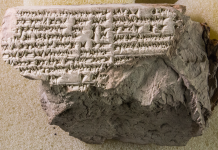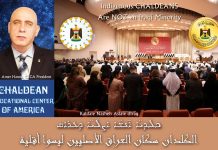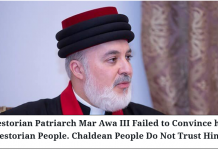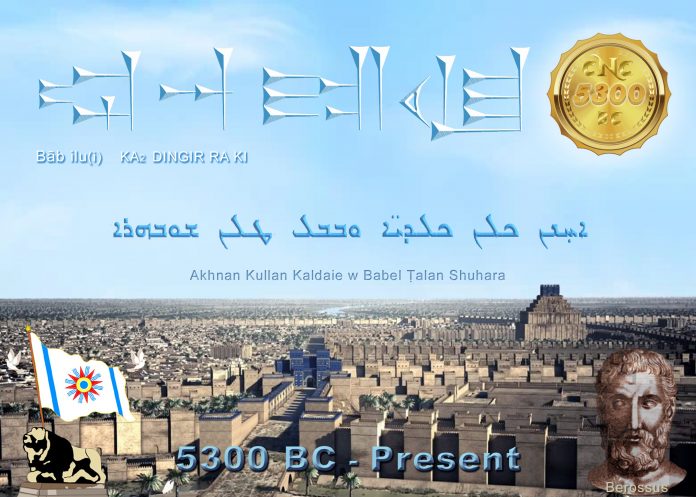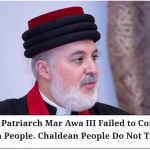“How did Chaldeans compute their National Calendar, 5300 BC to Present?”Download
On the occasion of welcoming, the Chaldean Babylonian New Year Festival AKITU 7323k on April 1st, 2023
One may ask how Chaldeans did calculate the actual date of the Chaldean-Babylonian calendar and what archaeological, Biblical, and scientific evidence support this conclusion.
The Proto-Kaldi [1] celebrated the New Year Festival, AKITU / á-ki-ti-še-gur10-ku5, which used to take place in the month of Nisannu, when there was an equal amount of daylight and darkness, and recounts the “rebirth” of the natural order.
Present-day Chaldeans (descendants of the Proto-Kaldi) resumed celebrating AKITU worldwide starting with the Chaldean Educational Center of America Akitu (CECA) Celebration in 2000. CECA followed and honored the traditional joyous days of the New Year Festival that their Proto-Kaldi forefathers celebrated since the first Chaldean capital Eridu founded in the 6th millennium BC in the heart of the Chaldean historical homeland Mat-Kaldu. This 5300 BC remarkable national festival marks the beginning of Chaldean Babylonian history.
To unify the native Mesopotamians, our Babylonian ancestors decided around 1894 BC to combine the two ancient New Year celebrations, Akitu (during the spring equinox in the month Nisannu) and SHAG-ḪUL ZAG-MUK, which literally means “beginning of the year” (celebrated at the autumn equinox in the month Elulu/Tashritu / Sept-Oct).
The Babylonians were the first to celebrate the unified New Year Festival of AKITU in Babylon. Since then, Babylon become the only legitimate urban to conduct this holy event between April 1st and April 11th.
The only exception took place around 689 BC post the nine-month siege and conquest of Babylon in 691 by Sennacherib who systemically sacked Babylon. However, moving the statue of Marduḫ to Assur and celebrating Akitu over there did not last for long. The reign of Sennacherib ended in his assassination by his sons while he was praying in front of the Marduḫ statue. His own children killed him for the destruction he brought about on Babylon the most sacred city of Mesopotamia. When Esarhaddon became the king in 680 BC he hastened to return the statue of Marduḫ and rebuild Babylon as he regarded the sacred city with feelings of respect and reverence. He also reinstated the Babylonian Akitu. This fact is supported by vast historians and archeologists who also assert that Chaldeans are the indigenous Mesopotamians whose local dynasties ruled both states of Babylonia and Assyria.
It is worth noting that the New Year Festival rituals began in Babylonia and were continued for thousands of years over there until its last performance in the second century BC. This well-documented fact indubitably indicates beyond doubt, that Chaldean history which began in 5300 BC is a solid fact that can be proved beyond doubt according to the following:
1- Any Mesopotamialogist knows that giving two cities the same name was rare, yet it was an acceptable or most likely unpleasant practice. On the other hand, it was forbidden to use the sacred name of an existing temple by people of another city because temples in ancient Mesopotamia were considered living beings, and a living being cannot exist in two places at the same time. However, both Eridu and Babylon were called by the same ancient name Nunki, and the É-sagila temple’s name was deliberately used in both cities!
What is quite fascinating about this point is that the people who built Eridu and its suburb Ku-ara of Marduḫ/Asarluḫi are the same ones who built Babylon and its temple É-sagila.
2- Eridu and Babylon are the only cities in ancient Mesopotamia that hold the same exact name (NUN.KI) which means the homeland of life. This sacred name applied only to two cities throughout Mesopotamian long history; Eridu according to the (Nam-Lugal) list and Babylon according to Berossus’ Chronicles!
It is also worth noting that the sacred neighborhood in Babylon where the Tower of Babylon/Ziggurat É-temenanki and É-sagila, the temple of Marduḫ are located is called Eridu.
3- The records of the Chaldean King Nabu-nasir (Nabonassar, 747-734 BC), who admits destroying most of the historical records of the Chaldean kings who preceded him, mentions “Nabonassar collected together the records of the deeds of the kings before him and destroyed them so that the reckoning of Chaldean kings might start with himself.” [2]
It is also documented that Sennacherib in 689 BC not only destroyed most of the Chaldean’s records, burned libraries, and demolished the temples, but he also destroyed the entire city of Babylon as was recorded in his own chronicles:
[“Sennacherib avenged himself on Babylon and dared to accomplish the unthinkable: he destroyed the illustrious and sacred city, the second metropolis of the empire, the ‘BOND of HEAVEN and EARTH’ which his forebears had always treated with infinite patience and respect: “As hurricane proceeds, I attacked it and, like a storm, I overthrew it . . . Its inhabitants, young and old, l did not spare and with their corpses, I filled the streets of the city . . . The town itself and its houses, from their foundations to their roofs I devastated, I destroyed, by fire I overthrew . . . So that in future even the soil of its temples be forgotten, by water I ravaged it, I turned it into pastures.”] [3]
Roux, Georges, Ancient Iraq, Penguin books1992, P 322
4- The Bible confirms in more than one place the very deep and rich history of the Chaldeans asserting that they are a Nation since ancient times (A long-lived nation, an ancient nation … Jeremiah 5:15 U.S. Catholic Bible). However, the two books of Genesis and Jeremiah could easily validate this fact.
5- Nebuchadnezzar II, ᵈna bi um ku dur ri ú ṣuur, the sun king and the maker of wonders 604–562 BC, is a king like no other king in ancient history. Nebuchadnezzar II attained the zenith of celebrity status as the builder of great Babylon in his golden era. He was the mastermind of one of the Seven Wonders of the World, the Tower of Babel, and Babylon’s walls. He is the king who was biblically allowed to return to God’s grace after being punished. (Daniel:4).
In his chronicles, Nebuchadnezzar called himself, the king of Babylon, the King of Akkad, the King of Sumer and Akkad. He also linked his family tree to the Akkadian emperor, Naram-sin 2254-2118 BC.
It is worth noting that, Sargon the Great, in his chronicles, stated that he built his city-state of Akkad with the holy sand of Babylon. Sargon the Great is considered the first emperor in the world’s history and is famously known as a descendant of the Proto-Kaldi. Sargon was originally from Kish, the first city-state that ruled the Babylonian region Post- deluge (Great Flood). Furthermore, Kish from the onomatology angle is the name which the biblical names Kush, kasdim/Kašdim, and Chaldean are derived from. Hassan al-Najafi, the prominent historian, is the first contemporary Arab scholar that used the name Chaldean to designate the ethnicity of Empirer Sargon of Akkad in his compelling encyclopedic book, Dictionary of Terms and Biographies in Mesopotamia, Vol I, Baghdad, 1983. Likewise, the renowned Babylonian historian, Berossus, listed Sargon the Great among 191 Chaldean kings, in his three-volume BABYLONIACA, [1] starting with Kosmabelos. The same ethnicity/nationality designation, Chaldean, that was used by Berossus, was also used by other scholars, i.e., A. Scher, Y. R. Ghanimah, etc.
6- The famous ancient encyclopedia BABYLONIACA was in part a combination of the most reliable ancient Mesopotamian records and was highly valued by the Greek and other classical historians. Babyloniaca, aka Chaldeanica, asserts that “a Chaldean dynasty was the first to rule Mesopotamia since the Post-deluge time.” It also confirmed that the first Mesopotamian king was Chaldean.
[1] Baqer,Tah, The Epic of Gilgamesh, Other Stories of Gilgamesh and the Flood, 5th ed., Baghdad, 1986, P 209 / See also: The Babylonian Akītu Festival and the Ritual Humiliation of the King
By Sam Mirelman https://www.asor.org/anetoday/2022/09/babylonian-festival-and-ritual-humiliation
Conclusion: The court of law usually requires two witnesses to ratify a testimony, which is exactly what the Bible also requires. However, I have brought to your attention not two or three but five solid references. I could also add to the abovementioned tens of linguistic proofs and other historical records that exist in Mesopotamian literature, which I have covered in detail in my published books since 1988, especially the 2021 groundbreaking book Chaldean Legacy, the most reliable and highly prised by genuine reviews made possible by scholars and many online reviewers. The deep and rich study of this unmatched and undeniable academic book is based on hundreds of academic references. Likewise, my encyclopedic 2012 book The Untold Story of Native Iraqis based on more than 600 academic references, is among the top sources concerning this subject.
Amer Hanna Fatuhi, Ph.D.
Visual Artist & Historian
www.ChaldeanLegacy.com | www.NativeIraqis-Story.com | www.JewsofBabylon-Book.com
Acknowledgment. I would like to extend my cordial thanks to Professor Roy Gessford from Let in the Light publishing company for editing the article.
[1] Proto-Kaldi: In 1988, historian Amer Hanna Fatuhi named pre-Sumerian cultureProto-Kaldi. This term was first used in his study entitled “Ur of Chadeans … An Iraqi Perspective”. Subsequently, it became common among
Iraqi scholars since 1990s and worldwide in 2004.
[2] Oates, Joan, BABYLON, Thames & Hudson, revised ed. 1986 and reprinted 2000, P 113
[3] Roux, Georges, Ancient Iraq, Penguin books1992, P 322
[4] Baqer, Baqer, Tah, The Epic of Gilgamesh, Other Stories of Gilgamesh and the Flood,
5th ed., Baghdad, 1986, P 209 / See also: “The Babylonian Akītu Festival and the Ritual Humiliation of the King” By Sam Mirelman https://www.asor.org/anetoday/2022/09/babylonian-festival-and-ritual-humiliation







